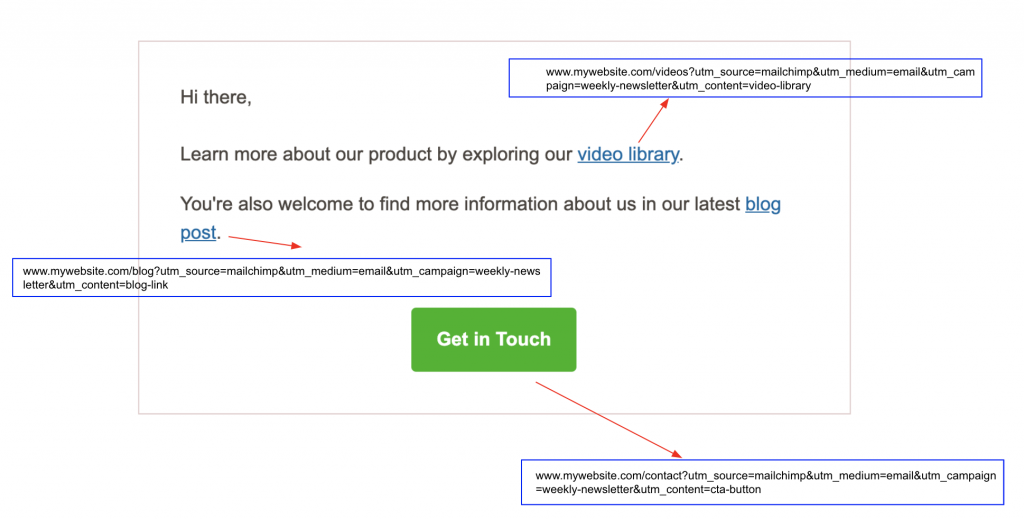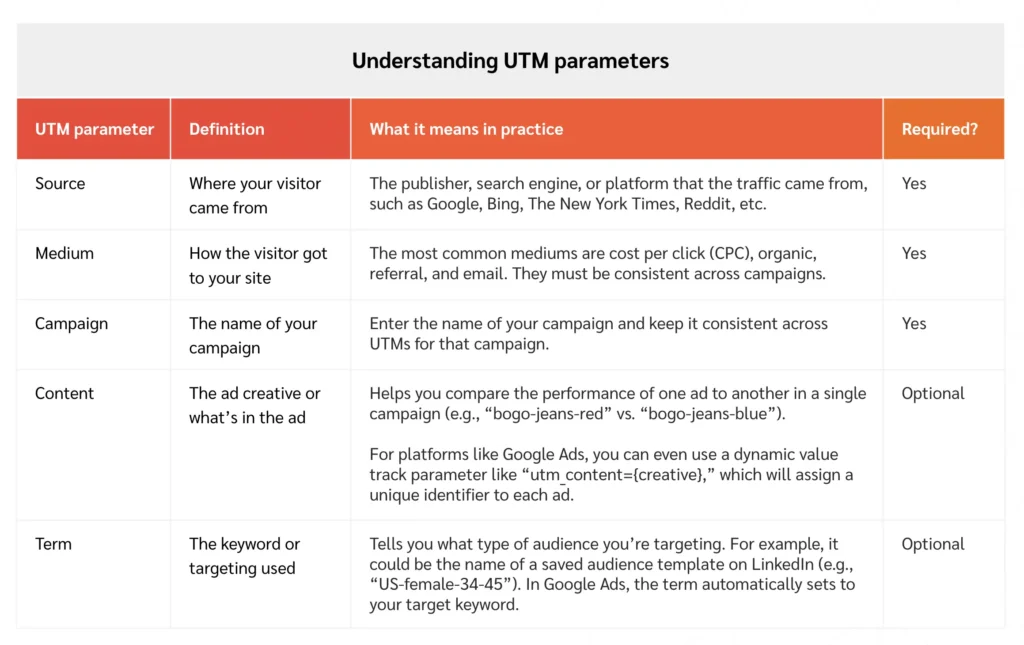Understanding your primary sources of web traffic is essential for growing your audience, measuring campaign success, and, ultimately, increasing revenue. But managing this data is often easier said than done.
If you drive traffic to your website to generate affiliate sales, you’ve probably at least heard of Urchin Tracking Modules (UTMs). UTMs are everywhere, but there’s often confusion about how to apply them correctly—and this confusion can create barriers to unifying your data.
Here are the six most common UTM mistakes and how to avoid them:
- Not using UTMs
- Mixing up UTM parameters
- Inconsistent naming, spelling, and capitalization
- Using different campaign names across channels
- Using UTMs for internal links
- Not merging UTMs with affiliate data to track revenue
Mistake 1. Not using UTMs
Let’s start by exploring what UTM tracking is and why it’s important.
UTMs make up pieces of text—called parameters or tags—added to the end of URLs. UTM tracking tells analytics solutions like Google Analytics where your website traffic comes from.
The structure of a UTM always stays the same:
- The URL itself
- A question mark
- Multiple UTM parameters

Why are UTMs so valuable?
UTMs allow you to pin down where your website traffic comes from—even down to the specific ad or keyword that generated it. While Google and Bing ads automatically add UTM tags to your links, other crucial traffic sources do not.
For example, if you spend thousands of dollars on Facebook ads to send traffic to your site, the only way you can assess how well those ads perform is to tag them with UTMs. UTM tagging allows Google Analytics and other tracking solutions to identify traffic from a paid Facebook ad. With the correct tagging conventions in place, they can show you the type of targeting and creative you used.
UTMs give you key pieces of information to develop a more effective content amplification strategy.
UTMs for email marketing
Proper UTM tagging also comes into play with email marketing. Creating good email campaigns takes a lot of time and effort, but without UTMs, you can only understand their effectiveness with open and click rates.
Without UTM parameters in your email links, Google Analytics usually classifies the traffic as direct—a black hole of lost traffic acquisition data. With the right UTM tagging, you can see which links in your emails bring in visitors and, ultimately, sales.

UTMs for referrals from other websites
When you manually provide links to other websites to use in their content, you need to add UTM parameters. This allows you to measure the effectiveness of your digital partnerships and evaluate the performance of specific syndication campaigns you run.
UTMs and your affiliate sales data
When you use UTMs, you can easily merge your traffic source and campaign metrics with your affiliate sales data—giving you insight into your true return on investment (ROI).
However, you’ll also need a way to ensure that the UTM tracking values link back to the purchase on the retailer’s website via the affiliate network. Linking back to UTMs can be challenging to set up on your own—unless you have the help of an affiliate data management solution like impact.com for Publishers.
If you want to understand the quality of the traffic you bring to your site with regard to actual affiliate revenue, as most do, then UTMs are an absolute must.
Mistake 2. Mixing up UTM parameters
UTM parameters can be confusing. Though it’s a common mistake, accidentally switching your UTM parameters can muddle and devalue your data. Let’s dive into what each UTM parameter means.
Understanding UTM parameters
There are five possible UTM tracking parameters you can add to your URLs—all of which serve different purposes. Some UTM parameters are required, while others add more detail to your UTM if desired.

Differentiating source vs. medium
Source and medium are the most commonly confused UTM parameters, even by some of the most experienced marketers.
To help you keep them straight, think of the source as the where and the medium as the how.
For example, if a visitor enters your site from bing.com from an organic search result, the source would be Bing (where the visitor came from), and the medium would be organic (how the visitor reached you). If a visitor comes to your site from a paid Bing ad, the source would still be Bing, but in this instance, the medium would be paid.
Need more clarity?
Let’s say a visitor entered your site from a social Facebook post. The UTM parameters would be:
- Source: Facebook
- Medium: Social
Alternatively, if they came from a paid Facebook ad:
- Source: Quora
- Medium: Referral
With emails, the source isn’t as obvious. The medium is email, but the source could be the name of the email platform you’re using (e.g., Mailchimp) or something like “marketing emails” or even “newsletter.” Just make sure you apply the consistently across UTMs.
Mistake 3. Inconsistent naming conventions, spelling, and capitalization
Keeping your parameter naming conventions consistent is essential for unifying your data. For example, having one UTM source say “facebook” and another say “fb-social” could permanently splinter your data. This makes it difficult to have a single holistic view of your data and can hinder efforts to create a data-led strategy.
Don’t let the hard work you put into tagging your URLs go to waste. Follow these tips to help create UTM parameter continuity.
Use lowercase
UTMs are case sensitive. “Facebook” and “facebook” will appear in your reports as two different sources. Use lowercase for all your values to help avoid running into trouble with inconsistent capitalization.
Name your mediums clearly and consistently
It doesn’t matter how you name your medium as long as:
- The meaning is clear to you and your team
- You apply it consistently across all your marketing activity
For example, your medium for pay-per-click (PPC) ads could be “PPC” or “paid.” Avoid using both unless you aim to indicate something substantially different (e.g., PPC vs. sponsored content).
When you name your medium and source clearly and consistently, you create richer aggregated reports that easily compare the performance of your different paid channels.
Watch out for spelling and plurals
You and your team should be vigilant about typos and misspellings when creating UTMs.
For example, If one person in your organization uses “utm_medium=referral” to indicate non-paid links from other websites and another uses “utm_medium=referrals,” these will show up as two distinct mediums in your Google Analytics reports. If another person misspells it as “utm_medium=refferal,” that will give you three mediums for what should have been one.
Document your UTM naming conventions
Create an internal document that outlines your UTM tracking parameter naming conventions. This strategy reduces discrepancies and ambiguity and provides an easy way for your organization to stay consistent.
Mistake 4. Using different campaign names across channels
The more you streamline and standardize the way you name campaigns, the easier you can compare performance across other dimensions.
You splinter your data when you give campaigns different names for different channels. Instead, you want to have the same campaign name to compare the campaign’s performance between the two channels.
The best approach for naming your campaigns
When it comes to naming your campaigns, think of the important attributes you use to distinguish one campaign from another and ensure they make it into your campaign name. Ideally, you want these to be abbreviated but standardized and easily decipherable.
If you take a more granular approach to your tracking, you might want to include whether the campaign targets desktop or mobile. You may also want to identify the geographic location, campaign theme, or product (e.g., UK-Mobile-Summer-Sale).
Whatever you decide to include, ensure you and your team follow the same guidelines and apply them consistently.
Mistake 5. Using UTMs for internal links
Avoid using UTMs for internal links at all costs. Doing this ends the current session and creates a new one. Any subsequent conversions are then attributed to the internal source rather than the original traffic source—eliminating valuable data from your arsenal.
Mistake 6. Not merging UTMs with affiliate data to track revenue
Even after creating your naming conventions and tagging all of your links, you’re still missing a key piece of the puzzle: how much revenue your pages actually made.
If you can’t connect the data in your UTMs with affiliate sales, much of your campaign optimization will ultimately be guesswork.
Carry over this data and connect it to affiliate purchases and commissions so you can calculate your true ROI. This allows you to analyze each UTM dimension in the context of affiliate performance.
Connecting your affiliate data with UTM data can be challenging from a technical standpoint. A revenue attribution tool can make this task easier. It ensures your UTM values (and other data you want to track) directly link to your affiliate network sales data.
Many revenue attribution tools also help you visualize and analyze all this data. Trackonomics by impact.com—a part of the impact.com for Publishers suite—offers a flexible, customizable dashboard that allows you to slice and dice data by different UTM tracking dimensions and other important metrics like author, page, category, subsection, and more.
What happens to the original UTM values if users visit multiple pages before making a purchase?
The complexity of the user journey presents another challenge with UTMs in the context of affiliate sales. Readers frequently visit multiple web pages in the same session before making a purchase via an affiliate link.
Unfortunately, when the user goes to multiple pages before converting, the UTM values from the original landing page get lost along the way. That means all the insights about the source of the affiliate revenue get lost, too.
When you store the original UTM values while a user navigates your website, you can attribute a sale to the original traffic source. While this may be difficult to achieve on your own, impact.com for Publishers’ revenue attribution technology retains your original UTM values. This makes it possible to link affiliate sales back to the original traffic source the user came from.
Maximize your affiliate tracking capabilities
To stay ahead of the curve in today’s competitive publishing industry, you need to know where your traffic comes from. Using revenue attribution technology like the capabilities offered by impact.com for Publishers helps you take your tracking to the next level.
Learn more about the only full-stack tech solution that keeps publishers competitive in a constantly evolving ecosystem.




